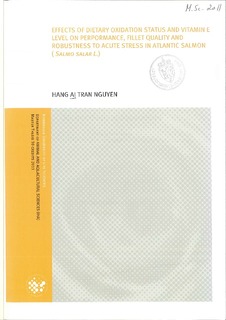| dc.description.abstract | The effects of oxidized dietary lipid and the role of vitamin E on the growth performance, biometric traits, blood parameters, muscle pH and fillet quality of Atlantic salmon (Salmo salar L.) were evaluated after a 79-day feeding period. Five hundred sixty fish with mean initial bodyweight of 2.12 kg were distributed into eight cages and fed four different experimental diets. The salmon were fed a commercial diet added fresh or oxidized rapeseed oil with standard (200mg/kg) or elevated (1200mg/kg) vitamin E. The fresh and oxidized rapeseed oil used had the anisidin value of 2.3 and 33 (meq peroxide/kg) and peroxide value of 3.3 and 24 (meq peroxide/kg), respectively.
Growth performance showed no significant dietary effects, but the feed conversion rate (FCR) of the fish fed fresh oil in combination with elevated vitamin E was lowest compared with other diets. No significant differences in organ adhesions (Speilberg score), spleen somatic index, slaughter yield, fillet yield or fillet fat content were observed due to dietary treatment. However, oxidized oil tended to increase heart somatic index and significantly reduced the fillet thickness. Livers of salmon fed high vitamin E levels were larger and paler than those of salmon fed the diets without vitamin E supplementation, irrespective of oil quality. The fish were slaughtered immediately after netting (non-stressed) or they were kept in seawater with decreasing dissolved oxygen (DO), from 9 to 2mg/L (stressed) before slaughtering. For the non-stressed group, supplementation with vitamin E resulted in higher levels of Na+ and K+ in the blood, while oxidized lipid had tended to increase the hemoglobin level although these effects were not significant. The diet added fresh oil without vitamin E supplementation had significantly highest pH after 3h storage, but no significant dietary effects were observed on muscle pH after 24h, pH in blood, liquid loss or gaping., Vitamin E supplementation had a positive effect on the fillet firmness, independent of dietary oil quality. Acute stress due to exposure to low DO level had a negative effect on the osmoregulation, muscle pH after 3h and liquid loss whereas no significant effects on firmness or gaping were observed. However, vitamin E supplementation appeared to lower Na+ and K+ increase and drop in muscle pH due to acute stress. Statistical analyses revealed significant interactions between stress and oxidized oil. Indeed, hemoglobin level was higher and pH in blood was lower of the fish fed oxidized oil than in those fed. These results demonstrated that feed containing oxidized oil increased the hemoglobin concentration, accelerated glycolytic activity post-mortem and also negatively affected the fillet thickness. Salmon fed oxidized oil had less ability to cope with acute stress, in particular impaired osmoregulation ability. High vitamin E levels improved the feed utilization, fillet firmness and the ability of the fish to cope with acute stress before slaughtering. However, paler and larger livers, increased Na+ and K+ levels in the blood and faster pH drop in the muscle post-mortem might be considered as negative. Hence the level and period of vitamin E supplementation need to be ascertained to achieve optimal production efficiency, physiological status and fillet quality of farmed salmon. | no_NO |
